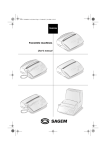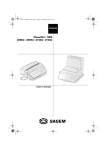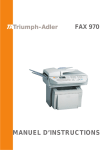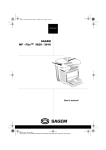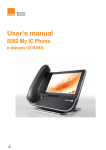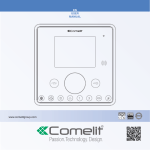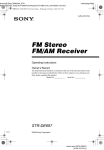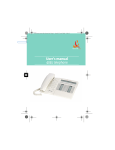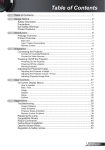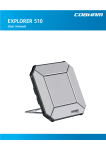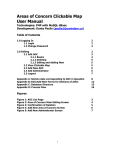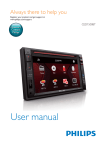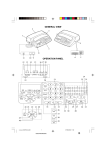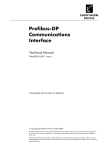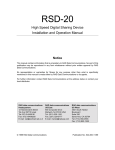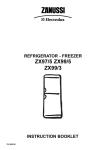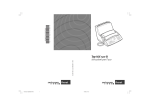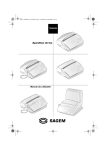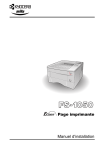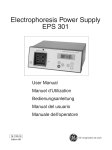Download 7(/(&20 - Support Sagemcom
Transcript
1COUV.fm Page 1 Lundi, 10. décembre 2001 3:52 15
7(/(&20
)DFVLPLOHPDFKLQHV
User’s manual
2COUV.fm Page 2 Lundi, 10. décembre 2001 3:53 15
2YHUYLHZ
3KRQHID[
Paper tray
Document feeder
Handset
Rear cover
DECT kit module
connector
Control panel
Front cover
Handset connector
Telephone line connector
3KRQHID[
Access door to paper and
document feeders
Handset connector
3KRQHID[
Telephone line connector
Paper feeder
Document feeder
)D[
Access door to paper and
document feeders
Telephone line connector
)D[
Paper feeder
Document feeder
Telephone line connector
Légende.fm Page 1 Lundi, 10. décembre 2001 3:54 15
2SHUDWLRQSDQHO
10
3
7
1
2
4
6
5
8 9
or
ou
(
)
(
)
20
18 17
19
13
16
1
key: to print documents received in the memory
2
key: to play back messages received on the
answering machine
• blinking: presence of messages not played back
• steady: presence of played back messages
or
3
4
5
6
7
8
to delete from memory the document currently
printed (models without TAD)
LCD display screen composed of a 16-characters line
key: choice of fax transmission resolution or local
copy (NORMAL, FINE or PHOTO)
key: choice of reception mode (TEL, FAX, TAD):
• TEL (T): telephone in service (for models with handset)
• FAX (F): automatic fax reception
• TAD (A): TAD in service (for TAD-models)
12
13
14
10
11
(REDIAL) key: automatic call-back of one of the last
10 called numbers
Alphanumeric keypad
(START) key: fax transmission, or local copy
(LOUDSPEAKER) key: use of line without
key: move up in menus or to the left in an entry
field - Volume up
15
key: confirmation of the displayed selection
16
(MENU) key: access to the various functions
17
key: move down in menus or to the right in an entry
field - Volume down
18
19
20
9
(STOP) key: stop of the operation in progress, or
unhooking, hands-free mode (depending on
model) or amplified listening
key: insertion of a dialling break (/), or flash feature
(PABX)
11
activation of the secret mode
(DIRECTORY) key: access to directory
key: printing of the menus guide
12
15
14
key: return to previous displayed message or clearing of
the last character entered in an entry field
Direct access keys to the first 10 directory memories
keys: preprogrammed keys to access the
following functions:
: list of callers
: night mode
: access to the print menu
Description différents modèles.fm Page 1 Lundi, 10. décembre 2001 3:54 15
Description of the various fax models
'(6&5,37,212)7+(9$5,286)$;
02'(/6
7+(9$5,286)81&7,216
Fixed paper tray (100 pages)
+DQGVHW
7$'
+DQGVIUHH
3URYLGHGZLWK
DFRUGOHVV
SKRQHVHW
;
;
;
;
;
Document feeder (15 pages)
3KRQHID[
;
3KRQHID[
Removeable paper feeder
(30 pages)
Document feeder (15 pages)
3KRQHID[
Sheet by sheet paper feeder
(1 page)
Document feeder (1 page)
Removeable paper feeder
(30 pages)
Document feeder (15 pages)
)D[
Sheet by sheet paper feeder
(1 page)
Document feeder (1 page)
)D[
;
;
;
;
;
;
;
;
;
;
;
;
Guide Menu.fm Page 1 Lundi, 10. décembre 2001 3:53 15
Quick reference guide, menu guide
48,&.5()(5(1&(*8,'(0(18*8,'(
',5(&725<0(18 3UHVV
)XQFWLRQFDOOHG
)XQFWLRQGHVFULSWLRQ
6HHSDJH
M 11 OK
ADD NAME
Add a record into the directory
11
M 12 OK
MODIFY
Modify a record in the directory
12
M 13 OK
CANCEL
Delete a record from the directory
13
M 14 OK
PRINT
Print the directory
13
6(77,1*60(18
3UHVV
)XQFWLRQFDOOHG
)XQFWLRQGHVFULSWLRQ
6HHSDJH
M 21 OK
DATE/TIME
Enter the date and time
15
M 22 OK
NUMBER/NAME
Enter your fax number and name
15
M 23 OK
MELODIES/BEEPS
Choose the ring melody and key beeps
15
M 231 OK
M 232 OK
M 233 OK
M 24 OK
M 241 OK
M 242 OK
ALARM
Choose the ring melody
Choose the key beeps
Switch alarm On/Off
NETWORK
Set network parameters
MELODY
BEEPS
NETWORK TYPE
PREFIX
16
Select network type
Set the prefix
M 25 OK
NIGHT MODE
Control the night mode
M 26 OK
NB OF RINGS
Set the number of rings
17
M 27 OK
CORDLESS
Cordless phone (depending on model)
17
M 271 OK
HANDSET REGIS
Register handset (depending on model)
M 272 OK
HANDSET ERASE
De-register handset (depending on model)
M 273 OK
HANDSET CODE
Radio encryption code (depending on model)
M 28 OK
SECURITY
17
M 281 OK
MEM ACCESS
M 282 OK
REMOTE CODE
Protected access (depending on model)
Lock fax and voice messages (depending on
model)
Remote interrogation code (depending on model)
M 29 OK
LANGUAGE
Choice of the language:
English, French, German, Spanish or Italian
18
16
)$;0(18 3UHVV
)XQFWLRQFDOOHG
)XQFWLRQGHVFULSWLRQ
6HHSDJH
M 31 OK
FCT TRANSM
Delayed transmission and broadcasting
21
M 32 OK
POLLING ACTV
Perform an active polling
24
M 33 OK
POLLING PASS
Perform a passive polling
23
M 34 OK
SEND REPORT
Print choice of the transmission report
21
M 35 OK
TX FROM MEM
Transmission from the memory or document
feeder
21
M 36 OK
RX IN MEM
Reception of documents into the memory or on
paper
22
Guide Menu.fm Page 2 Lundi, 10. décembre 2001 3:53 15
Quick reference guide, menu guide
7$'0(18 7$'02'(/6
3UHVV
)XQFWLRQFDOOHG
)XQFWLRQGHVFULSWLRQ
6HHSDJH
M 41 OK
OGM RECORD
Record the outgoing greeting message
M 42 OK
OGM PLAYING
Play back the outgoing greeting message
25
M 43 OK
MEMO
Record a message (memo)
26
M 44 OK
DELETE MSG
Delete the voice messages
26
M 45 OK
TYPE
Select the type of TAD
25
M 46 OK
FILTERING
Select the call filtering feature
28
M 47 OK
PRIVIL ACCES
Select the privileged access mode
28
M 48 OK
PRIVIL CODE
Select the privileged access code
28
25
35,17,1*/2&$/&23<0(18 3UHVV
)XQFWLRQFDOOHG
)XQFWLRQGHVFULSWLRQ
6HHSDJH
M 51 OK
GUIDE
Print the menus
M 52 OK
LOGS
Print the Tx and Rx logs
33
M 53 OK
DIRECTORY
Print the directory
33
M 54 OK
SETTINGS
Print the setting list
33
M 55 OK
SEND REPORT
LOCAL COPY
M 57 OK
RIBBON GAUGE
Print the last comm. report
Choose the number of copies
(depending on model)
Display the ribbon gauge status
33
M 56 OK
33
33
34
'2&80(17&21752/0(18 3UHVV
)XQFWLRQFDOOHG
)XQFWLRQGHVFULSWLRQ
6HHSDJH
M 61 OK
PERFORM
Perform a pending command
35
M 62 OK
MODIFY
Modify a pending command
35
M 63 OK
CANCEL
Cancel a pending command
35
M 64 OK
PRINTING DOC
Print a pending document
35
M 65 OK
PRINT LIST
Print the command list
36
$'9$1&(')81&7,2160(18 3UHVV
M 72 OK
)XQFWLRQFDOOHG
RELAY
M 721 OK
ON
M 722 OK
OFF
M 723 OK
SETUP
M 79 OK
TECHNICAL
)XQFWLRQGHVFULSWLRQ
New broadcast of vocal and fax messages
(depending on model)
Activating the new broadcast
(depending on model)
Deactivating the new broadcast
(depending on model)
Setting the new broadcast parameters
(depending on model)
Modification of the technical parameters
6HHSDJH
37
38
LIASSE 23690427-6TDM.fm Page 3 Lundi, 10. décembre 2001 3:55 15
&217(176
,1752'8&7,21 8QSDFNLQJ
&RQQHFWLRQV 6ZLWFKLQJRQ /RDGLQJWKHSDSHU &KRRVLQJWKHRSHUDWLQJPRGH7(/)$;7$' 7KHPHQXV 7(/(3+21,1* &DOOLQJ $QVZHULQJDFDOO )XQFWLRQVDYDLODEOHGXULQJDFDOO ',5(&725<0(18 &UHDWLQJDUHFRUG 0DNLQJDFDOOIURPWKHGLUHFWRU\ (GLWLQJDUHFRUG 'HOHWLQJDUHFRUG 3ULQWLQJWKHGLUHFWRU\ 6(77,1*60(18 'DWH7LPH 1XPEHU1DPH 5LQJLQJPHORG\DQGNH\EHHSV 1HWZRUN 1LJKWPRGH 1XPEHURIULQJVIRUWKHDXWRPDWLFPRGH &RUGOHVVSKRQH 3URWHFWLRQRI\RXUPDFKLQHGHSHQGLQJRQPRGHO &KRLFHRIWKHODQJXDJH )$;0(18 ,QVHUWLQJWKHGRFXPHQWLQWRWKHIHHGHU 6HQGLQJDID[
5HFHLYLQJDID[ 'XULQJWUDQVPLVVLRQ
$GYDQFHGIXQFWLRQV
7$'0(18 0RGHOVZLWKWDGLQWHUQDO
0RGHOVZLWKYRFDOWDGH[WHUQDO 35,17,1*/2&$/&23<0(18 3ULQWLQJ /RFDOFRS\ 5LEERQJDXJHGLVSOD\ LIASSE 23690427-6TDM.fm Page 4 Lundi, 10. décembre 2001 3:55 15
'2&80(17&21752/0(18 ([HFXWLQJDSHQGLQJFRPPDQG &RQVXOWLQJRUPRGLI\LQJWKHTXHXH 'HOHWLQJDFRPPDQGIURPWKHTXHXH 3ULQWDGRFXPHQWZDLWLQJIRUWUDQVPLVVLRQ 3ULQWLQJRXWWKHOLVWRISHQGLQJRSHUDWLRQV $'9$1&(')81&7,2160(18 5HOD\LQJUHFHLYHGGRFXPHQWVGHSHQGLQJRQPRGHO 7HFKQLFDOSDUDPHWHUV 5HPRWHFRQWUROIURPDQH[WHQVLRQVHW 237,216 'LVSOD\ $33(1',; 5HSODFHPHQWRIFRQVXPDEOHV
7URXEOHVKRRWLQJ &RGHVRIWKHWUDQVPLVVLRQUHSRUW This unit has been designed in accordande with European standards I-CTR37 and CTR21, it
is designed for connection to the Public Switched Telephone Network (PSTN). In case of any
problems, first contact your Supplier.
The CE mark attests that the products complies with the essential requirements of Directive
R&TTE 1999/5/EC, for user safety, in accordance with Directives 73/23/EC for electromagnetic interference, in accordance with Directive 89/336/EC.
And that it makes efficient use of the radio spectrum allocated to terrestrial communications.
The manufacturer declares that the products are manufactured in accordance with ANNEX II
of Directive R&TTE 1999/5/EC.
SAFETY WARNINGS
!
Before powering on your unit, make sure the mains outlet it is connected to
meets the requirements printed on the warning label on your unit (Voltage,
Current, Frequency of power network), or on the separate power supply
(depending on the model). If your unit works with a separate Power Supply,
use only the one delivered with your unit; never use another power supply.
The unit’s mains plug is the only way to disconnect the unit from the power
network. Therefore you must respect the following:
• Your unit must be connected to a mains outlet located nearby.
• The mains outlet must remain easily accessible.
Your unit is delivered with a power cord including a plug which, depending
on the model,
may be:
• without earth (the
symbol on the warning label)
• with earth (no symbol
on the warning label).
It is imperative that a power plug with an earth be connected to a wall outlet
with an earth.
In Europe, this unit includes the
stamp, following the 73/23/CEE, 89/
23226033-4
336/CEE and 93/68/CEE directives.
23226033-4 cdsnolaser_GB.p65
1
02/06/2000, 16:05
LIASSE 23690427-6.book Page 1 Lundi, 10. décembre 2001 3:56 15
Introduction
Introduction
,1752'8&7,21
813$&.,1*
Telephoning
Check for the following items when unpacking your machine:
• Main unit,
• Power cord,
• Handset (depending on model),
• Telephone line cord,
1
Directory
• Paper holder(*),
• DECT kit (cordless phone, charger and base station)(**).
2
An ink ribbon and its gauge card are pre-installed in the machine. You will have to replace them when
they are worn (please refer to § Replacement of consumables on page 41).
Settings
&211(&7,216
3
Caution - Please refer to the Safety Instructions at the beginning of this User’s manual.
Fax
&211(&7,212)7+(32:(5&25'
4
1
1
TAD
3
2
3
5
4
Printing
+ Turn your machine upside down.
+ Insert the plug (1) of the power cord into the connector (2) of the main unit.
+ Run the power cord (3) into the groove (4).
+ Replace your machine the right way round.
6
Doc control
Advanced
functions
Options
(*)
(**)
Models with a fixed paper tray (100 sheets).
Depending on model.
Appendix
1
7
LIASSE 23690427-6.book Page 2 Lundi, 10. décembre 2001 3:56 15
Introduction
&211(&7,212)7+(+$1'6(702'(/6:,7++$1'6(7
1
+ Connect the telephone handset cord to the appropriate connector (1) on the main unit.
&211(&7,212)7+(7(/(3+21(/,1(
)RUPRGHOVZLWKKDQGVHW
2
+ Connect the telephone line cord plug to the appropriate connector (2) on the main unit, and
connect the other end to the wall telephone
socket.
)RUWKHPRGHOVZLWKRXWKDQGVHW
1
+ Connect the telephone line cord plug to the ap2
propriate connector (1) on the main unit, and
connect the other end to the wall telephone
socket.
LIASSE 23690427-6.book Page 3 Lundi, 10. décembre 2001 3:56 15
Introduction
Introduction
6:,7&+,1*21
+
+
+
+
+
+
Connect the power plug to the mains wall socket.
The unit displays SELECT LANGUAGE.
Press OK to display the list of available languages.
Choose the language using the
or
Telephoning
key and press OK to confirm.
The unit displays CHECK DATE (with the selected language).
Press OK and enter the date and time, using the alphanumeric keypad.
1
Press OK to confirm.
Then, you can select another language, using the MENU 29 (please refer to § Choice of the
language on page 18).
Directory
/2$',1*7+(3$3(5
2
Settings
Paper feeders or trays may contain a varying number of pages (refer to the Description Table of the
various models given at the beginning of the present User's Manual).
You may use any standard plain paper (A4 format photocopying paper, approx. 80 g/m²). However, for
optimal print quality results, we suggest you to use the type of paper recommended by the manufacturer
(please refer to the last page of this User's manual).
3
Fax
❑ To avoid malfunctions and get optimal print quality, you should observe the following basic instructions:
• use perfectly new paper without folds or rolled edges,
• do not reload the paper tray while printing is in progress,
• always remove all the pages left in the tray before reloading paper.
4
TAD
The method for installing the paper is different according to the model.
)2502'(/6:,7+$),;('3$3(575$<3$*(6
2
5
1
Printing
2
3
3
6
4
Doc control
Advanced
functions
+ Snap the paper holder (1) in the two slots (2) + Prepare
+
provided at the top of the sheet feeder.
Open the feeder cover (3)
+
+
a stack of plain paper (100 sheets
maximum)
Place the paper stack into the feeder (4).
Close the feeder cover (3).
Options
Appendix
3
7
LIASSE 23690427-6.book Page 4 Lundi, 10. décembre 2001 3:56 15
Introduction
02'(/6:,7+$5(029($%/(3$3(575$<
3$*(6
3
1
2
+ To open the cover (1), use notch (2) on the
+ Lift the paper support bracket (3).
side.
+ Prepare a stack of paper (30 sheets max.).
+ Insert it between the paper guides (4 and 6).
+ Press the clip (5) to insert the paper in the fax
4
machine’s paper store.
7
6
+ Adjust the left paper guide (4) to the width of
the paper.
Caution - Lift the support bracket (7) to facilitate
5
printout stacking.
)2502'(/6:,7+6+((7%<6+((73$3(5)(('(53$*(
+ Insert the paper sheets one after the other into
the paper feeder.
4
LIASSE 23690427-6.book Page 5 Lundi, 10. décembre 2001 3:56 15
Introduction
Introduction
&+226,1*7+(23(5$7,1*02'(TELFAXTAD
)2502'(/6:,7+7$'
Your machine has three distinct operating modes, which are described below automatically switches to
the fax reception mode:
• automatic mode with TAD: your machine answers all calls and records incoming messages,
• automatic mode without TAD: your machine sorts incoming calls before presenting them to you,
• manual mode: your fax machine never answers any calls automatically.
Telephoning
1
❑ In each of these three modes, you may pick up the handset at any time:
• when receiving a fax call, you can switch your fax machine to the fax reception mode by pressing the
Directory
key,
• when receiving a voice call, talk with the caller.
+
Press one or several times on the (
OK to confirm.
2
)-key to select the desired reception mode and press
Settings
$8720$7,&02'(:,7+7$'TELFAXTAD
Your unit works like a telephone answering device combined with a fax machine. Select that mode
when you go out or if you do not want to lose any fax or voice calls.
When your machine rings, it answers after the programmed number of rings and plays the greeting
message you have recorded on your TAD:
• if the call is a fax call, it automatically switches to the fax reception mode,
• if the call is a voice call, the caller will be able to leave a message.
3
Fax
❑ You can set the number of rings before your machine automatically answers
4
(please refer to § Number of rings for the automatic mode on page 17).
$8720$7,&02'(:,7+2877$'TELFAX
TAD
Your machine automatically sorts the calls before presenting them to you. Select that mode if you
receive many faxes and you do not want to be disturbed by their reception.
When it receives a call, your machine automatically answers without ringing(*), the caller can hear beeps
inviting him/her to wait, then:
• if the call is a fax call, it switches to the fax reception mode,
5
Printing
• if the call is a voice call, it rings (warning ring) for 30 seconds(**) and the caller can hear a ringing
tone. You can then pick up and talk. Otherwise, the caller will be able to leave a message on your
TAD, which will answer after 30 seconds and play the greeting message.
0$18$/02'(TEL
6
Doc control
Your machine mainly works like a telephone set: select that mode if you usually do not receive any faxes.
In that mode, your machine never answers automatically (except after 9 rings if remote interrogation is
enabled. In that case, it will play the greeting message).
)2502'(/6:,7+2877$'
Your machine has three distinct operating modes, which are described below:
• mode with fax: your machine automatically switches to the fax reception mode, you can connect an
external answering machine to receive your voice messages,
• automatic mode: your machine sorts incoming calls before presenting them to you,
• manual mode: your fax machine never answers any calls automatically.
+
Press the (
(*)
(**)
Advanced
functions
Options
)-key once or several times to select the operating mode required.
All other telephone sets in your installation, if any, will ring normally.
All other telephone sets in your installation, if any, will not ring.
Appendix
5
7
LIASSE 23690427-6.book Page 6 Lundi, 10. décembre 2001 3:56 15
Introduction
)D[PRGHFAX
Select this mode if you expect substantial fax traffic.
7KHXQLWLVQRWFRQQHFWHGWRDQH[WHUQDO7$'
Upon receiving an incoming call, the unit will ring and answer the call after a pre-set number of rings:
• if the call is a fax, the unit automatically switches to fax receive mode.
• if the call is a voice call, the latter will be lost unless you pick up the receiver before the programmed number of rings (i.e. before the unit automatically answers in fax receive mode).
7KHXQLWLVFRQQHFWHGWRDQH[WHUQDO7$'
Please refer to § Models with vocal tad (external) on page 31.
Upon receiving an incoming call, the unit will ring:
• if the call is a fax, the unit will automatically receive the fax.
• if the call is a voice call, the answering machine will automatically record the message left by the caller.
$XWRPDWLFPRGHTEL-FAX
The unit will switch incoming calls automatically. Select this mode if you expect substantial fax traffic and do
not wish to be inconvenienced by incoming faxes.
Upon receiving an incoming call, the unit automatically and silently answers the call (*), plays a serie of beeps
prompting the caller to wait, then:
• if the call is a fax, the unit automatically switches to fax receive mode,
• if the call is a voice call, the unit will ring for 30 seconds(**). If you fail to pick up the receiver, the unit will
then automatically switch to fax receive mode.
The caller can therefore send you a fax.
0DQXDOPRGHTEL
The unit will function like a standard phone terminal. Select this mode if you expect little fax traffic.
7KHXQLWLVQRWFRQQHFWHGWRDQH[WHUQDO7$'
Upon receiving an incoming call, the unit will ring but will not automatically answer the call. To take the call
manually, pick up the handset:
• if the call is a voice call, simply converse with the caller,
• if the call is a fax, press
then hang up and your unit will automatically switch to fax receive mode.
7KHXQLWLVFRQQHFWHGWRDQH[WHUQDO7$'
Please refer to § Models with vocal tad (external) on page 31.
Upon receiving an incoming call, the unit will ring:
• if the call is a voice call, your answering machine will answer the call automatically and record any message left by the caller,
• if the call is a fax, the unit will automatically switch to fax receive mode.
)257+(02'(/6:,7+287+$1'6(7
$XWRPDWLFPRGH
Your unit receives faxes automatically with no action on your part (automatic FAX mode).
0DQXDOPRGH
Upon receiving an incoming call, the unit will ring but you can not answer to an incoming call.
(*)
(**)
6
The unit will not play the ringing tone generated by the telephone network. However, if there are any other phone
terminals on the line, these will ring as normal.
If there are any other phone terminals on the line, these will not ring.
LIASSE 23690427-6.book Page 7 Lundi, 10. décembre 2001 3:56 15
Introduction
Introduction
❑ If you’ve got a cordless phone kit, your machine has three distinct operating modes (with fax,
automatic and manual). Please refer to § For models without TAD on page 5.
You have to use the cordless phone to answer a call (you can’t use the
-key of your
machine to answer a call).
7+(0(186
Telephoning
$&&(66,1*7+(0(186
As described in the next sections, your machine features many functions accessible through the menus,
which allow you to set and modify them: recording a directory of numbers, memorising received or sent
faxes, setting the number of rings, etc.
1
Directory
As can be seen in the menu guide, all functions are numbered in a main menu (e.g.1. Directory), from
which you can access the various settings for the selected function (e.g. 1.1 Add, 1.2 Modify, 1.3 Cancel
or 1.4 Print a directory record).
0DLQPHQXDFFHVVWRIXQFWLRQV
+
2
Settings
Press the M key.
3
6XEPHQXVDFFHVVWRIXQFWLRQVHWWLQJV
+
Press the
key to select the previous menu line.
+
Press the
key to select the next menu line.
+
Press the OK key to confirm and go on to the next menu.
+
Press the C key to return to the previous menu.
Fax
4
TAD
5
+
Press the
(START) key to confirm and exit from the main menu.
+
Press the
(STOP) key to exit from the current menu.
Printing
0RYLQJLQVLGHDGDWDHQWU\ILHOG
+
+
6
Press the C key to delete the last character.
Doc control
Hold the C key down to delete all the characters entered.
+
Press the
key to move the cursor to the left within a data entry field
+
Press the
key to move the cursor to the right within a data entry field
+
Press the
+
Press the OK key to confirm entry and go on to the next menu item.
+
Press the
Advanced
functions
key to cancel entry and return to the initial value.
Options
(START) key to confirm entry and exit from the current menu.
Appendix
7
7
LIASSE 23690427-6.book Page 8 Lundi, 10. décembre 2001 3:56 15
Introduction
35,17,1*7+(0(18*8,'(
To print the menus and thus get an overview of menus, proceed as follows:
+
+
Insert paper.
Press the M, 5, 1 and OK keys (or press the i key).
The menus are classified in their order of function number. (See the section entitled QUICK REFERENCE
GUIDE, MENU GUIDE). The functions are classified in their order of appearance in this manual. Tabs are
provided for quick access to the required information.
8
LIASSE 23690427-6.book Page 9 Lundi, 10. décembre 2001 3:56 15
Telephoning
Introduction
7(/(3+21,1*
Although it features advanced functions, your machine is also a telephone set providing a whole range of
user-friendly functions.
Telephoning
&$//,1*
1
&$//,1*86,1*7+(+$1'6(7
+ Pick up the handset.
+ Dial your party’s number.
Directory
You can also dial the number before picking up the handset. In that case, you can correct any dialling
error by means of the C key.
❑ You can use the
and
&$//,1*86,1*7+(
2
Settings
keys to adjust the volume (2 levels available).
.(<
/RXGVSHDNHUOLVWHQLQJ
+
+
+
+
+
3
Dial your party's number. This is displayed on the screen.
Fax
Pick up the handset, the machine dials automatically.
When your party answers, press the
You can use the
Press the
and
key to activate loudspeaker listening.
keys to adjust the volume.
4
key again to de-activate loudspeaker listening.
TAD
+DQGVIUHHPRGH7$'0RGHOV
+
+
+
Dial your party's number.
Press the
You can use the
5
key: the machine dials automatically.
and
keys to adjust the volume..
Printing
❑ At any time, you can pick up the handset and continue the call (in which case the speaker and
microphone are automatically disabled).
&$//,1*86,1*7+(',5(&725<
Your machine can store phone numbers in a directory. To know the applicable procedure, please refer to
the section entitled DIRECTORY (MENU 1).
5(',$//,1*21(2)7+(/$677(1180%(56&$//('
+ Press the (REDIAL) key.
+ Select the required number using the and keys .
+ To call the number displayed press the
key or pick up your handset.
❑ At any time, you can delete the REDIAL number by pressing the C,
6
Doc control
Advanced
functions
(REDIAL) and OK
keys.
Options
Appendix
9
7
LIASSE 23690427-6.book Page 10 Lundi, 10. décembre 2001 3:56 15
Telephoning
$16:(5,1*$&$//
When someone calls you, your phone rings. Pick up your handset (or press the
key for the TAD and
Hands-free models) and speak. To end the call, hang up the handset (or press the
key).
)81&7,216$9$,/$%/('85,1*$&$//
.12:,1*7+('85$7,212)7+(&$//
Ten seconds after dialling, a counter displays the approximate duration of the call.
$&7,9$7,1*/28'63($.(5/,67(1,1*
During the call, press the
key. This will activate the loudspeaker, enabling another person to listen to
the conversation.
6:,7&+,1*)520+$1'6(772+$1'6)5((02'(7$'02'(/6
+ Hold down the
key.
+ Hang up the handset.
+ Release the
key. Conversation then goes on in the hands-free mode.
$&7,9$7,1*7+(087(
During a call, if you want your party not to hear you for a while, press the
key. Press that key again to resume
your conversation.
5(&25',1*$&$//'(3(1',1*2102'(/
During a handset call, you can record the conversation.
+
+
+
+
Press the M and
To stop recording, press
keys: recording starts.
.
To listen to the recording, press
.
To delete the recording, press M, 4, 4 and OK.
5(5287,1*$&$//
To reroute a call to another set (connected to the same telephone line):
+
+
+
Press the M and
key.
Hang up the handset.
Go to the other set, pick up and continue the call.
❑ You should hang up the handset within 4 seconds. You have about 25 ìseconds to pick up the other handset.
6:,7&+72)$;5(&(37,2102'(
If you pick up a secondary handset or take the line from a cordless phone and you cannot hear anyone speaking,
you can switch your machine remotely to fax reception mode by typing # then 7.
10
LIASSE 23690427-6.book Page 11 Lundi, 10. décembre 2001 3:56 15
Directory (Menu 1)
Introduction
',5(&725<0(18 The directory is a file in which you can store phone and fax numbers, especially those of the parties you
call most frequently. So, instead of dialling a phone or fax number each time you want to communicate
with one of your parties, you just have to select their names from the directory. Using the data you have
stored, your machine will do it all automatically for you.
Telephoning
❑ The records stored in the directory are classified in alphabetical order.
1
&5($7,1*$5(&25'
Directory
To fill in the directory, enter each party’s phone number and name in a record. To create a new record and
add it to the directory:
+ PRESS THE M, 1, 1, OK KEYS
❑ You can cancel the process at any time by pressing
2
Settings
.
<2853$57<
61$0(
+ Enter your contact’s name or a handle using the alphanumeric keypad.
3
By pressing a key once or several times, the corresponding letters are scrolled.
To enter "LONDON" for instance, perform the following sequence:
3 times 3 times
L
O
2 times 1 time 3 times
N
D
O
Fax
2 times
4
N
TAD
❑ You can move in the data entry field using the
or
key:
• you can delete the last character entered by briefly pressing the C key,
• you can delete all the characters entered by holding the C key down,
• you can insert a space by pressing twice the 0 key.
+
5
Press the OK key to confirm.
Printing
<2853$57<
6180%(5
+ Then, enter your party's phone and/or fax number.
+ Press the OK key to confirm.
6
❑ If your fax machine is in the premises of a company, it may be connected to a private automatic
branch exchange (PABX). Some of these telephone exchanges require the insertion of a dialling
prefix (e.g. 0). All numbers should be stored in the directory without that prefix. You can program the prefix automatically for all numbers (please refer to § Prefix on page 16). Some telephone exchanges also require the insertion of a post-dial delay. If such is the case, press the R key
in order to insert the post-dial delay (the character / is inserted in the number displayed).
180%(5$66,*1('
Doc control
Advanced
functions
Each new sheet created is assigned a two-digit number by which you can directly access the
corresponding sheet.
Options
❑ The last ten records are associated to the ten one-touch dialling keys (00-09).
+
Validate the number assigned automatically or enter a number of your choice and press OK to
confirm.
Appendix
11
7
LIASSE 23690427-6.book Page 12 Lundi, 10. décembre 2001 3:56 15
Directory (Menu 1)
0$.,1*$&$//)5207+(',5(&725<
Once you have stored all your parties’ numbers and names in the directory, you can select one of them (to phone
or send a fax) using either his name or abbreviated number as explained below.
6(/(&7,21%<1$0(
+ Press the key then use keys
+ Then you can:
and
• pick up the handset or press
to scroll through the records in alphabetical order.
to call him,
or
• place a document in the document feeder and press
to fax the document.
6(/(&7,21%<$%%5(9,$7('180%(5
Your fax machine has automatically associated a 2-digit abbreviated number to each newly created record: 00 for
the 1st record, 04 for the 5th record, and so on.
+
Press twice the
Then you can:
key then dial your party's abbreviated number.
• pick up the handset or press
to call him,
or
• place a document in the document feeder and press
to fax the document.
❑ If you do not remember which abbreviated number corresponds to a record, you can print out the directory for a copy of all the information it contains (please refer to § Printing the directory on page 13).
6(/(&7,21%<21(728&+',$//,1*.(<
+ Press one of the one-touch dialling keys (numbered 00 to 09).
Then you can:
• pick up the handset or press
to call him,
or
• place a document in the document feeder and press
to fax the document.
(',7,1*$5(&25'
+
+ PRESS M, 1, 2, OK
To select a record:
• Use keys
and
ted number).
• Press the OK key.
+
12
to scroll through the records in alphabetical order (or dial your party’s abbrevia-
To correct the data in the record (name, phone/fax number, etc.), use the
,
and C keys: edit the
relevant data using the alphanumeric keypad and press OK to confirm and go on to the next data.
LIASSE 23690427-6.book Page 13 Lundi, 10. décembre 2001 3:56 15
Directory (Menu 1)
Introduction
'(/(7,1*$5(&25'
+
+ PRESS M, 1, 3, OK
Select the record you want to delete by using the
and press OK twice to confirm.
The record will be deleted.
or
keys (or dial its abbreviated number)
Telephoning
35,17,1*7+(',5(&725<
1
+ PRESS M, 1, 4, OK
Directory
The directory is printed automatically. This document contains all the information you have entered
(name, phone/fax number, as well as the abbreviated numbers automatically associated to each record).
2
Settings
3
Fax
4
TAD
5
Printing
6
Doc control
Advanced
functions
Options
Appendix
13
7
LIASSE 23690427-6.book Page 14 Lundi, 10. décembre 2001 3:56 15
Directory (Menu 1)
14
LIASSE 23690427-6.book Page 15 Lundi, 10. décembre 2001 3:56 15
Settings (menu 2)
Introduction
6(77,1*60(18
The different settings enable you to customise calls and the operating mode of your machine (choosing a
ringing melody, storing faxes, etc.), but also set technical and security parameters (choosing a type of
network, locking, using an access code, etc.).
Telephoning
'$7(7,0(
+
1
+ PRESS M, 2, 1, OK
Directory
Enter the date and time using the numeric keypad and press OK to confirm.
Example: 7 May 2002, 9.15: press 0,7,0,5,0,2,0,9,1,5 and OK.
2
180%(51$0(
Settings
The data you enter in these fields will automatically be inserted in the headers of the faxes you will send,
so that they will be printed on the faxes received by your contacts.
3
❑ To do so, the TX HEADER setting should be enabled (please refer to § Technical parameters on
page 38).
+
+
Fax
+ PRESS M, 2, 2, OK
Enter your fax number and press OK to confirm and go on to the next field.
Enter your name (please refer to § Your party’s name on page 11) and press OK to confirm.
4
TAD
5,1*,1*0(/2'<$1'.(<%((36
You can choose between 4 melodies or WITHOUT MELODY and adjust the volume of the selected melody.
You can also program beeps that you will hear each time you press a key.
❑ If you choose WITHOUT MELODY, only the message INCOMING CALL, which is displayed on the
5
Printing
screen when you receive a call, will tell you someone is calling you.
5,1*,1*0(/2'<
+
+
+ PRESS M, 2, 3, 1, OK
Select the required melody using the
To adjust the volume, press the
or
or
key and press OK to confirm.
$/$50
+
Doc control
key and press OK to confirm.
.(<%((36
+
6
+ PRESS M, 2, 3, 2, OK
Select WITH or WITHOUT and press OK to confirm.
Advanced
functions
+ PRESS M, 2, 3, 3, OK
Select the required option using the
or
key and press OK to confirm.
• START: alarm switch-on.
Enter the time at which you want the alarm to ring out, and press the OK key to confirm: to the
right of the time, the screen displays a symbol indicating the alarm is in service.
• STOP: alarm switch-off.
❑ The alarm rings for 30 seconds. Press any key on the keypad to stop it earlier.
Options
Appendix
15
7
LIASSE 23690427-6.book Page 16 Lundi, 10. décembre 2001 3:56 15
Settings (menu 2)
1(7:25.
7<3(2)1(7:25.
The telephone line to which your machine is connected may be linked either to the public network or to a private
network (e.g; in a company with a PABX).
+
+ PRESS M, 2, 4, 1, OK
Select the type of network, PABX (private) or PSTN (public), to which you are connected and press OK to
confirm.
35(),;
If your machine is connected to the private automatic branch exchange (PABX) of a company, you have to enter
a prefix (generally 0) for outgoing calls before the number you want to call, provided that:
• the intercom numbers (for which no prefix is required) are short numbers not exceeding the minimum
length from which the prefix should automatically be inserted (to be defined),
• the external numbers (for which a prefix is always required) are long numbers exceeding or equalling the
minimum length from which the prefix should automatically be inserted (to be defined, for instance 10
digits in the UK).
+
IMPORTANT NOTE: Do not change anything in the numbers you have stored in the directory. Indeed,
enabling or disabling the prefix will respectively switch your machine to PABX operation (WITH prefix)
or PSTN operation (WITHOUT prefix).
To set the local prefix
+
+
+
+ PRESS M, 2, 4, 2, OK
Select the WITH option using the
or
key and press OK to confirm.
Enter the number used by your PABX to access the public telephone network (e.g. 0) followed by the /
sign (or pause, access by pressing the R key), and press OK to confirm.
If necessary, enter the phone number length from which the prefix should automatically be added (e.g. 10
digits in the UK) and press OK to confirm.
1,*+702'(
This mode enables you to switch off the ringing of your machine for a given period of time (during the night for
instance), while still receiving your calls. The machine then switches to automatic reception/TAD mode and will
answer after 5 rings. It will automatically receive all voice or fax messages. At the end of the NIGHT mode, the
screen displays the number of messages or fax received and the
and
keys blink, and your machine
automatically switches to the current reception mode. To activate the night mode:
+
+
+
+ PRESS M, 2, 5, OK
OR + PRESS F2
Select START using the
or
key and press OK to confirm.
Select the night mode start time and press OK to confirm.
Select the night mode stop time and press OK to confirm.
To deactivate the night mode,
+
16
+ PRESS M, 2, 5, OK
OR + PRESS F2
Select STOP using the
or
key and press OK to confirm.
LIASSE 23690427-6.book Page 17 Lundi, 10. décembre 2001 3:56 15
Settings (menu 2)
Introduction
180%(52)5,1*6)257+($8720$7,&02'(
This function enables you to set the number of rings before the automatic activation of your telephone
answering device.
+
+ PRESS M, 2, 6, OK
Telephoning
Change the number of rings and press OK to confirm.
&25'/(663+21(
1
Directory
The machine can be used together with one or more cordless phone sets, which require the installation
of the cordless phone kit supplied with your machine or available from your supplier. Please refer to the
instructions coming with the kit for more information. When fitted with that kit, your machine gives you
access to the functions described below.
5(*,67(5,1*$&25'/(663+21(
2
Settings
For each cordless phone you want to register on your machine:
+
+ PRESS M, 2, 7, 1, OK
On the cordless phone, press OK and 6. A number specific to each handset appears on its display
screen.
'(5(*,67(5,1*$&25'/(663+21(
3
Fax
+ PRESS M, 2, 7, 2, OK
The main unit’s screen displays the numbers for the registered handset.
+
4
Enter the number corresponding to the handset you want to de-register and press OK. Your
machine emits a series of beeps telling you that de-registration is in progress.
%$6(67$7,215(*,675$7,21&2'(
TAD
+ PRESS M, 2, 7, 3, OK
This function enables you to define a 4-digit registration code intended to protect your base station, e.g.
from the registration of handset that do not belong to you but are in the same reception zone as your
machine.
5
Printing
3527(&7,212)<2850$&+,1('(3(1',1*2102'(/
6
3527(&7,212)92,&(25)$;0(66$*(6
Doc control
You can protect all your messages by a code, which you will have to enter prior to consulting them. To
do so, you have to set a message access lock and choose an interrogation code other than 0000.
0HVVDJHDFFHVVORFN
+
+
+ PRESS M, 2, 8, 1, OK
Select the required option using the
or
key:
• WITHOUT: no interrogation code for local access to the messages,
• WITH: local access to the messages is possible only after entering the interrogation code.
Advanced
functions
Options
Press OK to confirm.
Appendix
17
7
LIASSE 23690427-6.book Page 18 Lundi, 10. décembre 2001 3:56 15
Settings (menu 2)
$FFHVVWRORFNHGPHVVDJHV
If you have chosen WITH message access lock, the message access procedure is as follows:
+ Press the or , depending on the type of messages (fax or voice messages).
+ Enter the remote interrogation code.
5(027(,17(552*$7,21&2'(
This function is used to define the remote interrogation code for any voice or fax messages received.
+
+
+ PRESS M, 2, 8, 2, OK
Enter your code.
Press OK to confirm.
&+2,&(2)7+(/$1*8$*(
You can choose the language displayed on the screen:
+
+
18
+ PRESS M, 2, 9, OK
Select the language (ENGLISH, FRANÇAIS, DEUTSCH, ESPAÑOL, ITALIANO) using the
press OK to confirm.
or
key and
Press OK and choose the corresponding network (for the Display Caller Service) and press OK to confirm.
LIASSE 23690427-6.book Page 19 Lundi, 10. décembre 2001 3:56 15
Fax (Menu 3)
Introduction
)$;0(18 ,16(57,1*7+('2&80(17,1727+()(('(5
Telephoning
02'(/6:,7+$),;('3$3(575$<
1
Directory
1
2
2
Settings
3
+ The document feeder (1) receives up to 15 pa- + Insert the document, printed face down, into
ges.
+
Fax
the document feeder. If necessary, adjust the
left paper guide (2) to the width of the document.
The machine displays READY.
4
❑ Your machine has an automatic document feeder. The last sheet in the stack will be sent out first.
TAD
02'(/6:,7+$5(029($%/(3$3(575$<
5
1
Printing
3
2
4
6
Doc control
+ Lift the fax access door (1).
+ Insert the document, printed face down, into
+ Lift the document support bracket (2).
the document feeder. If necessary, adjust the
+ The document feeder (3) receives up to 15 paleft paper guide (4) to the width of the docuges.
Advanced
functions
ment.
+ The machine displays READY.
Options
❑ Your machine has an automatic document feeder. The last sheet in the stack will be sent out first.
Appendix
19
7
LIASSE 23690427-6.book Page 20 Lundi, 10. décembre 2001 3:56 15
Fax (Menu 3)
02'(/6:,7+$6+((7%<6+((73$3(5)(('(5
1
+ The document feeder (1) receives up to 1 page. + Insert the document, printed face down, into
the document feeder.
+ The machine displays READY.
Caution - To remove a sheet from the feeder or from the paper tray, press
.
6(1',1*$)$;
'2&80(175(62/87,21
Your machine has three resolution modes. You will select one of these modes according to the type and print
quality of the document you want to fax.
• standard mode: for a good quality document without minute details.
•
•
+
(FINE) mode: for a document with small characters or drawings.
(PHOTO) mode: when the document is a photograph.
Press the
on the screen.
key once or several times to change the resolution mode. The mode selected is displayed
6(1',1*$)$;
,PPHGLDWHWUDQVPLVVLRQ
+
+
Insert the document into the feeder, printed face down, first page last in the stack of sheets (for models
whose feeder can accommodate several pages).
Dial the addressee's fax number and press
to confirm.
7UDQVPLVVLRQIURPWKHGLUHFWRU\
When all your parties' names and numbers are stored in the directory you can select one of them (to phone them
or send them a fax), please refer to § Making a call from the directory on page 12, for further information.
%URDGFDVWWUDQVPLVVLRQ
To send the same document to several addressees, proceed as follows:
+
+
+
20
Place the document into the feeder, dial the fax number of the first addressee, or select it from the directory.
Press the OK key to confirm.
Dial the fax number of the next addressee or select it from the directory. Press the OK key to confirm.
Repeat this procedure for all the addressees you wish to include in this broadcast (maximum 6), making
sure you validate the last addressee by pressing the
key to start an immediate transmission.
LIASSE 23690427-6.book Page 21 Lundi, 10. décembre 2001 3:56 15
Fax (Menu 3)
Introduction
'HOD\HGWUDQVPLVVLRQ
To program delayed transmission for a document, proceed as follows:
+
+
+
Insert the document into the feeder.
+ PRESS M, 3, 1, OK
Dial the addressee’s fax number.
Telephoning
Press OK if you want to enter another addressee.
or
+
+
Press twice OK and enter the time at which you want your fax to be sent and press OK to confirm.
Choose the required type of transmission (from the machine’s MEMORY or from the document
PAPER FEEDER) and press OK to confirm. (please refer to § Transmission from the machine’s
memory or the document feeder on page 21, for further information).
1
Directory
+ Enter the number of pages of the document and press OK to confirm.
&+226,1*7+(7<3(2)75$160,66,215(3257
2
You can program your machine so that a transmission report is printed each time you send a fax. There
are three types of report available:
+
+
Settings
+ PRESS M, 3, 4, OK
Select the required option using the
or
key:
• WITH: a transmission report is printed if there has been no transmission problem or if it is definitively aborted (i.e. after 6 unsuccessful attempts). So, there is only one report for each transmission request.
• WITHOUT: no report is printed following a fax transmission (consult the transmission log to
keep track of all communications).
• IF ERROR: a transmission report is printed after each unsuccessful transmission attempt.
3
Fax
4
TAD
Press OK to confirm.
75$160,66,21)5207+(0$&+,1(
60(025<257+('2&80(17)(('(5
You can choose between two modes of transmission:
• from the machine's memory: the document to be faxed is stored in your machine's memory before
it is sent. This mode enables you to pick up original copies more quickly and to send a fax to several
addresses.
• from the document feeder: the document is faxed right after placing it in the feeder and dialling.
This mode enables you to send voluminous documents whose size may exceed the memory capacity.
+
+
+ PRESS M, 3, 5, OK
Select the required option using the
or
key.
• MEMORY:
The document is first stored in the memory of your fax machine, then it is transmitted.
• ADF:
Document scanning and transmission are performed at the same time. If the addressee's fax
machine does not answer, the documents remains in the feeder.
5
Printing
6
Doc control
Advanced
functions
Press OK to confirm.
Options
Appendix
21
7
LIASSE 23690427-6.book Page 22 Lundi, 10. décembre 2001 3:56 15
Fax (Menu 3)
5(&(,9,1*$)$;
Your machine has a reception memory enabling it to receive your faxes even when out of paper. Depending on
the settings made, your machine can print out your faxes as soon as these are received or store them in its memory.
When at least one fax is present in the memory, the
key of your machine blinks. The key is off if there
is no fax in the memory or if you have printed all the faxes received.
35,17,1*)$;(65(&(,9(',17+(0(025<
+ To print out stored faxes, put paper in the paper tray, and press the
key. If the machine runs out
of paper, add some so that printing restarts automatically after the last printed page.
❑ You can protect the access to your faxes by means of a code (please refer to § Protection of voice or fax
messages on page 17, for more information).
5(&(37,21)5207+(0(025<)$;$16:(5,1*0$&+,1(25',5(&735,17,1*
When activated, this function enables you to store all messages received in the memory, until you choose to print
them out. When the function is de-activated, all documents are printed as soon as they are received.
+
+ PRESS M, 3, 6, OK
Select the required option using the
or
key:
• WITH: the documents you receive are stored in the memory,
• WITHOUT: the documents you receive are printed at once (if there is paper in the feeder),
+ Press OK to confirm.
5(027(,17(552*$7,212)7+()$;$16:(5,1*0$&+,1(7$'02'(/6
If you are away and have a fax machine where you are (set to the tone dialling mode), you can retrieve and print
the faxes received on you own fax machine.
❑ As delivered, the remote interrogation option is not available: to interrogate your fax answering machine
remotely, you should first enter an interrogation code, which is shared with the TAD (so that you can also
listen to your voice messages). Please refer to § Remote interrogation code on page 18, for more information and set your machine to the "automatic reception with TAD" mode.
+
+
+
+
On a remote fax machine featuring a telephone set, dial your own number.
Press the * key during the greeting message, then enter the 4 digits of your interrogation code: the machine
first delivers the voice messages (if there are any).
As you hear the beeps, press the 8 then 0 keys.
Switch on the fax machine by pressing the
key as soon as you hear the fax tone: (if no fax has been
memorised, your fax machine will deliver a series of beeps) your own fax machine will then forward all
the faxes stored in its memory.
Caution - When you interrogate your fax answering machine remotely, the forwarded documents are
automatically erased from its memory.
5(&(37,210(025<6$785$7,21
When there are too many documents or voice messages in the memory, the machine is saturated and will not be
able to take in any extra message: the MEMORY FULL message appears on the screen. Print the stored faxes and/
or erase all voice messages to get some spare memory.
22
LIASSE 23690427-6.book Page 23 Lundi, 10. décembre 2001 3:56 15
Fax (Menu 3)
Introduction
'85,1*75$160,66,21
67233,1*$75$160,66,21
+ Press the key.
+ Press the key again to confirm you want to stop the current transmission.
3+21(&$//6
Telephoning
7RFDOO\RXUSDUW\
1
You can call your party just after sending or receiving a fax. To do so, while the document is being
transmitted (send or receive mode), you should:
+
Press the
key while your fax machine displays TRANSMIS or RECEPTION. Your fax
machine then displays PHONE:
• once the fax has been transmitted, your party’s phone rings, if its machine is compatible,
• if he answers, your machine starts ringing: pick up the handset and speak.
Directory
2
Settings
<RXUSDUW\FDOOV\RX
When your party calls you, your phone rings and you can pick up the handset and speak.
3
$'9$1&(')81&7,216
Fax
32//,1*$'2&80(17
Polling a document consists in leaving it in your machine’s memory or document feeder, thus making it
available to one person (single polling), or several persons (multi polling), who can then perform "active
polling" on it. This requires that your machine be set to the automatic or fax mode.
+
+
+
+
+
4
TAD
Insert the document into the feeder.
+ PRESS M, 3, 3, OK
Select one of these two options using the
or
key:
• SINGLE POLLING: the document will be deleted from the memory as soon as it has been retrieved.
• MULTI POLLING: the document can be retrieved by several persons.
5
Printing
Press OK to confirm.
If you have selected SINGLE POLLING, you can then select one of the two following options with
keys
or
and press OK to confirm:
• MEMORY: the document is stored in your machine’s memory. This solution frees your machine.
• PAPER FEEDER.
6
Doc control
Enter the number of pages of the document and press OK to confirm.
❑ A message on the screen tells you if there is any document for polling. A single polling document
will automatically be deleted from the memory as soon as retrieved, unlike multi polling, which
you can cancel through menu 63 (please refer to § Deleting a command from the queue on
page 35).
Advanced
functions
Options
Appendix
23
7
LIASSE 23690427-6.book Page 24 Lundi, 10. décembre 2001 3:56 15
Fax (Menu 3)
5(75,(9,1*$'2&80(17
When a document has been polled on a remote fax, you can perform an "active polling" on it (i.e. print it out on
your own fax machine), only if there is no document in your feeder.
+
+
+ PRESS M, 3, 2, OK
Dial the number of the fax machine containing the polled fax and press the OK key.
Press the
key for immediate active polling.
or
+
Press twice OK for delayed active polling:
• Enter the time required for active polling, and press the
24
key to confirm.
LIASSE 23690427-6.book Page 25 Lundi, 10. décembre 2001 3:56 15
TAD (Menu 4)
Introduction
7$'0(18 02'(/6:,7+7$',17(51$/
Telephoning
Your machine features a telephone answering device (TAD) whose simple and extensive functions
provide a wide range of possibilities: leaving a message to persons calling you in your absence, letting
them leave you a message, interrogating your machine remotely as done for fax machines, etc.
Your TAD features two options:
• ANSWERING MACHINE: callers cannot leave you a message after the greeting message, which only
gives them some information.
• ANSWERING-RECORDING MACHINE: callers can leave you a message after the greeting message.
*5((7,1*0(66$*(6
The machine has 2 distinct greeting messages, corresponding to the two functions of the TAD (answering
machine or answering-recording machine).
1
Directory
2
Settings
$QVZHULQJUHFRUGLQJPDFKLQH
3
5HFRUGLQJWKHJUHHWLQJPHVVDJH
+
+
+ PRESS M, 4, 1, 1, OK
Fax
Pick up your handset and record your greeting message (20 seconds max.).
The time in seconds is counted down as you record your message.
Hang up your handset to stop the recording. Your message is then played back, after which you
can put your TAD into service.
4
TAD
3OD\LQJEDFNWKHJUHHWLQJPHVVDJH
+
+ PRESS M, 4, 2, 1, OK
Your machine plays back the greeting message you have recorded.
5
$QVZHULQJPDFKLQH
Printing
5HFRUGLQJWKHJUHHWLQJPHVVDJH
+
+
+ PRESS M, 4, 1, 2, OK
6
Pick up your handset and record your greeting message (90 seconds max.).
The time in seconds is counted down as you record your message.
Doc control
Hang up your handset to stop the recording. Your message is then played back, after which you
can put your TAD into service.
3OD\LQJEDFNWKHJUHHWLQJPHVVDJH
+
+ PRESS M, 4, 2, 2, OK
Your machine plays back the greeting message you have recorded.
Advanced
functions
6:,7&+,1*21
6HOHFWLQJWKHW\SHRI7$'
+
Options
+ PRESS M, 4, 5, OK
Select the required type of TAD (RECORD UNIT or ANSWER ONLY) using the
press OK to confirm.
or
key and
Appendix
25
7
LIASSE 23690427-6.book Page 26 Lundi, 10. décembre 2001 3:56 15
TAD (Menu 4)
6ZLWFKLQJWKH7$'RQ RII
6ZLWFKLQJRQ
+
+
)-key. When you are in mode TEL-FAX-TAD, your answering machine is on.
Press the (
Press OK to confirm.
6ZLWFKLQJRII
+
+
Press the (
)-key. When you are in mode TEL or TEL-FAX, your answering machine is off.
Press OK to confirm.
0(66$*(6
When you have received at least one message, the screen displays the total number of messages (except if there
is a pending command) and the
key on your machine blinks. This key is off if there are no pending
messages, and is steady on when all received messages have already been listened to.
/LVWHQLQJWRPHVVDJHV
+
Press the
key. For each message being listened to, the screen displays the sequence number
together with the date and time of reception.
While listening to the messages, you can press the following keys:
•
or
to adjust the audio volume,
• C twice to return to the beginning of the message,
• OK to skip to the next message,
•
for a pause. Press the same key again to resume listening,
• you can also use the remote interrogation controls (please refer to § Remote interrogation on
page 27).
/RFDOPHVVDJH
You can record a local message on your TAD, which will be like a message left by a remote caller. This function
is very useful when you have to go out of your office or home and you want to leave a message for anyone coming
in after you.
5HFRUGLQJWKHORFDOPHVVDJH
+ PRESS M AND
+
+
, OR
+ PRESS M, 4, 3, OK
Pick up the handset and record your message.
Hang up the handset to stop the recording.
3OD\LQJEDFNWKHORFDOPHVVDJH
+
Press the
key.
'HOHWLQJPHVVDJHV
'HOHWLQJDOOPHVVDJHV
+ PRESS C AND
, OR
+ PRESS M, 4 ,4, OK
❑ All messages must have been played back to be erased this way.
26
LIASSE 23690427-6.book Page 27 Lundi, 10. décembre 2001 3:56 15
TAD (Menu 4)
Introduction
'HOHWLQJDVHOHFWHGPHVVDJH
Individually, while listening to it, you can delete a message that has not been totally listened to.
+
Press the C key, then OK during the message you want to delete.
6DWXUDWLRQRIWKH7$'·VPHPRU\
When too many faxes have been received and too many messages have been recorded, your machine is
saturated and cannot take in any other message: the message MEMORY FULL is displayed. Print out the
faxes and/or delete the voice messages to get some spare memory.
Telephoning
5(027(,17(552*$7,21
You can interrogate your TAD remotely and thus listen to the messages you have received, only if the
telephone set you are calling from supports the tone dialling mode.
1
Directory
❑ As delivered, this option is not available: to interrogate your TAD remotely, you should first enter
a remote interrogation code, which is shared with the fax answering machine (so that you can
also print out the faxes received). Please refer to § Remote interrogation code on page 18, for
more information.
+
+
+
2
Settings
On a remote telephone set, dial your own number.
Press the * key during the greeting message, then enter the 4 digits of your interrogation code: the
machine delivers all the voice messages you have received.
3
After the last message or if there is no message, the machine emits a series of beeps.
List of available remote operations:
Fax
While listening:
• Pause or resume message listening by pressing
• Go to the next message by pressing
.
4
.
• Listen to the same message again by pressing
TAD
.
• Go back to the previous message again by pressing
. twice
5
After listening:
• Delete received messages by pressing
then
• Record your greeting message by pressing
Printing
.
then
and
stop the recording by pressing any key.
• Listen to your greeting message by pressing
• Switch on your TAD by pressing
.
• Switch off your TAD by pressing
.
• Resume message listening by pressing
6
.
Doc control
.
Advanced
functions
Options
Appendix
27
7
LIASSE 23690427-6.book Page 28 Lundi, 10. décembre 2001 3:56 15
TAD (Menu 4)
$'9$1&(')81&7,216
&DOOVFUHHQLQJ
This function enables you to listen to the caller leaving you a message on your TAD, before deciding on whether
to pick up or not.
+
+ PRESS M, 4, 6, OK
Select the required option using the
or
key:
• WITH: you can hear the messages as they are recorded on your TAD, and:
- adjust the SPEAKER volume using the
and
keys,
- pick up to answer the call.
• WITHOUT: messages are recorded in silence, only a message on the screen tells you you are receiving a
call and a message is being recorded:
- you can pick up to answer the call.
+
Press OK to confirm.
❑ The call screening feature is not available if you have activated the privileged access mode (see below).
3ULYLOHJHGDFFHVV
This function enables you to choose a code, which you will give to those persons who may call you at a given
moment (e.g. your collaborators during a meeting or your close relatives from a certain time).
3DUDPHWHULVDWLRQRIWKHSULYLOHJHGDFFHVVFRGH
+
+
+ PRESS M, 4, 8, OK
Enter a privileged access code other than 0000 and different from the remote interrogation code.
Press OK to confirm.
3XWWLQJWKHSULYLOHJHGDFFHVVPRGHLQWRVHUYLFH
+
+
+ PRESS M, 4, 7, OK
Choose WITH using the
and
keys.
Press OK to confirm.
3ULYLOHJHGFDOOV
Only those privileged callers having your access code will be able to call you.
To do so, they should proceed as follows:
+
+
+
Dial your number.
Wait until your unit answers.
Press the * key during the greeting message, then enter the 4 digits of your privileged access code: your
machine only starts ringing then.
❑ If you do not answer, the caller will have the possibility to leave a message on your TAD.
28
LIASSE 23690427-6.book Page 29 Lundi, 10. décembre 2001 3:56 15
TAD (Menu 4)
Introduction
'(7$&+$%/(48,&.5()(5(1&(&$5'
4XLFNUHIHUHQFHFDUGIRURSHUDWLQJ
\RXU7$'IHDWXULQJ
WKHUHPRWHLQWHUURJDWLRQIXQFWLRQ
Telephoning
Your TAD code: *
• Go to the next message by pressing
1
.
• Listen to the same message again by pressing
Directory
.
• Go back to the previous message by pressing
twice.
• Delete the received messages by pressing
2
then
Settings
.
• Record your greeting message by pressing
then
3
and stop the recording by pressing any key.
• Listen to your greeting message by pressing
• Switch on your TAD by pressing
.
• Switch off your TAD by pressing
.
• Resume message listening by pressing
.
Fax
4
.
TAD
From a fax machine:
• After listening to the message: 8, 0 then
to retrieve
the faxes stored in your machine’s memory.
5
Printing
6
Doc control
Advanced
functions
Options
Appendix
29
7
LIASSE 23690427-6.book Page 30 Lundi, 10. décembre 2001 3:56 15
TAD (Menu 4)
30
LIASSE 23690427-6.book Page 31 Lundi, 10. décembre 2001 3:56 15
TAD (Menu 4)
02'(/6:,7+92&$/7$'(;7(51$/
&211(&7,21
You can connect a telephone answering machine to your machine using the same telephone. This makes
your phonefax:
• a fax,
• a telephone,
• a personal telephone answering machine.
+
Connect the telephone line cord of your external answering machine (TAM) to the piggy back
connector of the telephone jack.
3877,1*,1726(59,&(
Make sure your TAD is permanently on (connected to the mains or in automatic mode).
86(
Please refer to § Choosing the operating mode (TEL-FAX-TAD) on page 5.
Caution - To ensure correct call sorting, the number of rings programmed in your unit must be greater than
the number of rings after which the external answering machine picks up.
31
LIASSE 23690427-6.book Page 32 Lundi, 10. décembre 2001 3:56 15
TAD (Menu 4)
32
LIASSE 23690427-6.book Page 33 Lundi, 10. décembre 2001 3:56 15
Printing & local copy (Menu 5)
Introduction
35,17,1*/2&$/&23<0(18 The Printing (MENU 5) can be accessed directly using the
key.
Telephoning
35,17,1*
)81&7,21*8,'(
1
+ PRESS M, 5, 1, OK
Directory
Prints the list of the numbered functions.
/2*6
+ PRESS M, 5, 2, OK
Prints the transmission and reception logs, which list the last 30 communications.
',5(&725<
2
Settings
+ PRESS M, 5, 3, OK
Prints the directory.
3
Fax
6(77,1*6
+ PRESS M, 5, 4, OK
Prints the list of your machine’s settings.
4
/$7(6775$160,66,215(3257
TAD
+ PRESS M, 5, 5, OK
/2&$/&23<
5
Printing
)2502'(/6:,7+'2&80(17)(('(5$&&2002'$7,1*3$*(6
3KRWRFRS\
6
The machine can be used as a photocopier.
+
+
+
Insert the document to be copied in the document feeder, as you would for a transmission.
Choose the resolution mode by pressing the
mode during local copying)..
Press the
Doc control
key (by default, your copier uses the FINE
key.
0XOWLFRS\PRGHOVZLWKIL[HGSDSHUWUD\
+
+
+ PRESS M, 5, 6, OK
Advanced
functions
Type in the number of copies you want to print on the numeric keypad (1 to 99).
Press the OK key: the document is stored and then printed.
Options
❑ The multicopy function cannot be used to print out a received fax; it applies only to a printed
document of which you want one or more duplicates.
Appendix
33
7
LIASSE 23690427-6.book Page 34 Lundi, 10. décembre 2001 3:56 15
Printing & local copy (Menu 5)
)2502'(/6:,7+'2&80(17)(('(5$&&2002'$7,1*3$*(
The machine can be used as a photocopier.
+ Insert the first page to be copied into the docu- + Insert a sheet of paper into the print feeder. The
ment feeder, as you would for a transmission.
+ Select the resolution mode by pressing on the
+
+
+
machine prints automatically your document.
(by default, your copier uses the
key
FINE mode during local copying).
Press on
, the machine memorises your document. Once the memorisation is completed,
the machine beeps and the screen displays INSERT DOCUMENT for a few seconds.
Insert the following page, then proceed similarly for the other pages of your document.
Press on
, once all the pages have been memorised: the screen displays OUT OF PAPER.
5,%%21*$8*(',63/$<
+ PRESS M, 5, 7, OK
The ribbon gauge shows the available quantity of ribbon in percent.
34
LIASSE 23690427-6.book Page 35 Lundi, 10. décembre 2001 3:56 15
Document control (Menu 6)
Introduction
'2&80(17&21752/0(18 A set of menus enables you to control all the pending commands (delayed transmission, passive polling,
active polling), and enables you to run, modify, cancel or delete them.
Telephoning
(;(&87,1*$3(1',1*&200$1'
1
This function is used to immediately execute a pending command:
+ PRESS M, 6, 1, OK
Directory
The status of the pending documents is shown:
• POL : ACTIVE POLLING
• TX : DELAYED TRANSMISSION
+
+
Select the required command using the
2
or
key.
Settings
Press the OK key to execute it.
&2168/7,1*2502',)<,1*7+(48(8(
+
+
+
3
+ PRESS M, 6, 2, OK
Select the command you want to consult or modify using the
or
Fax
key.
Press the OK key and modify the parameters for the displayed transmission request.
4
Press the OK key to confirm your changes.
TAD
'(/(7,1*$&200$1')5207+(48(8(
+
+
+
+ PRESS M, 6, 3, OK
Select the command you want to delete using the
or
5
Printing
key.
Press the OK key to delete the request from the queue.
Press the OK key to confirm deletion.
6
35,17$'2&80(17:$,7,1*)2575$160,66,21
Doc control
This function enables you to know the content of a document waiting for transmission.
+
+
+ PRESS M, 6, 4, OK
Select the pending document using the
or
key.
Advanced
functions
Press the OK key to print out the selected document.
Options
Appendix
35
7
LIASSE 23690427-6.book Page 36 Lundi, 10. décembre 2001 3:56 15
Document control (Menu 6)
35,17,1*2877+(/,672)3(1',1*23(5$7,216
This list shows, for each pending document: the sequence number of the pending operation, the addressee’s name,
the scheduled transmission time, the type of pending operation, the number of pages in the document and its size
(percentage of memory taken up by the document).
To print out the list,
+ PRESS M, 6, 5, OK
36
LIASSE 23690427-6.book Page 37 Lundi, 10. décembre 2001 3:56 15
Advanced functions (Menu 7)
Introduction
$'9$1&(')81&7,2160(18 5(/$<,1*5(&(,9(''2&80(176'(3(1',1*2102'(/
Telephoning
$&7,9$7,1*'($&7,9$7,1*7+(5(/$<)81&7,21
You can automatically relay all received messages (faxes or voice messages) to another telephone set or
fax machine.
+ PRESS M, 7, 2, OK
Choose one of the following three options using the
+
or
Directory
key, and press OK to confirm:
ON
• Enter the destination phone/fax number. Press OK to confirm.
• Choose the type of messages to be forwarded (VOCAL, FAX or VOC/FAX RELAY) and press OK
to confirm.
• If you have chosen VOCAL or VOC/FAX, enter the remote interrogation code of your answering machine (if not already done), and press OK to confirm.
• Choose SECURED RELAY or FREE RELAY and press OK to confirm.
• If you have chosen FAX and SECURED RELAY, enter the remote interrogation code of your
answering machine (if not already done), and press OK to confirm.
+
+
1
OFF:
2
Settings
3
Fax
all your messages will be kept in your fax machine.
SETUP:
if you have already activated the relay function once, this menu enables you to change a
number of parameters (addressee’s phone/fax number, type of messages to be relayed, remote
interrogation code, secured relay or free relay, etc.).
Once you have made the changes, validate menu 721>ON again by pressing the OK key in order
to re-activate the relay function taking the changes into account.
4
TAD
5(75,(9,1*5(/$<(''2&80(176
When receiving your relayed documents on the destination phone/fax, you should apply the following
procedure:
+
+
+
5
Printing
Pick up the handset.
Enter the remote interrogation code as you hear the beeps.
Then, follow the same procedure as for remote interrogation to listen to the voice messages and/
or receive the fax messages.
6
Doc control
Advanced
functions
Options
Appendix
37
7
LIASSE 23690427-6.book Page 38 Lundi, 10. décembre 2001 3:56 15
Advanced functions (Menu 7)
7(&+1,&$/3$5$0(7(56
The technical parameters are arranged into a list in which you move using the
technical parameters:
and
keys. To access
+ PRESS M, 7, 9, OK
02 TX HEADER:
you can insert your name, your fax number, the date and time on the header of
the fax received by the addressee.
03 TX LOCK UP:
lock up the fax transmission speed.
04 ANTI ECHO:
inhibit the satellite echo in case of fax problems in long-haul calls.
10 RX HEADER:
print the sender’s name and fax number as well as the date and time on the header
of the fax you receive.
11 RX LOCK UP:
lock up the fax reception speed.
20 REDUCE MODE:
choose the printing reduction mode (received faxes, local copies ): automatic or
fixed.
21 REDUCE RATE:
set the printing reduction rate.
22 NB OF PAGES:
give the number of pages printed (received faxes and local copies) since machine
switch-on.
40 RECALL LENGTH:
choose the in-line interrupt time (long or short) of the R key "Flash" signal.
50 SORTED PRINT:
print documents in reverse order of reception (or scanning for a local copy)
depending on model.
5(027(&21752/)520$1(;7(16,216(7
You can control your machine remotely from an extension tone dialling telephone set in your installation.
❑ If the extension set is configured in pulse dialling mode, type * to switch it to tone dialling mode.
6:,7&+,1*2))7+(7$'
If you take the line from an extension set and your machine did so before you and is playing your TAD’s greeting
message, press # then 0 to switch off the TAD.
6:,7&+,1*72)$;5(&(37,2102'(
If you take the line from an extension set and you cannot hear anyone speaking, you can switch your machine
remotely to fax reception mode by typing # then 7.
38
LIASSE 23690427-6.book Page 39 Lundi, 10. décembre 2001 3:56 15
Options
Introduction
237,216
',63/$<
Telephoning
If you subscribe to a caller display service, the machine will show the caller information on its display
and on the handset display.
0DFKLQHGLVSOD\
1
Directory
NUMBER ONLY
INCOMING CALL
Number
+DQGVHWGLVSOD\
NUMBER/NAME
2
------
INCOMING CALL
Number withheld
alternating with
Settings
WITHHELD
INCOMING CALL
Number unavailable
alternating with
3
UNAVAILABLE
Fax
INCOMING CALL
Operator
alternating with
UNAVAILABLE
INCOMING CALL
International
4
alternating with
TAD
UNAVAILABLE
NUMBER
INCOMING CALL
Payphone
alternating with
NUMBER
5
NUMBER ONLY
INCOMING CALL
Ringback
Printing
alternating with
NUMBER/NAME
If the call is from a number stored in the machine’s directory, the display will show the name it belongs
to rather than the number. The handset display will only show the number.
The machine stores the date, time and number or name of up to 10 calls - after 10 calls have been stored
it retains the last 10. If a new call is from the same number as an earlier call only the later call details will
be stored. Number Withheld, Number Unavailable, Operator and International calls will not be stored.
6
Doc control
The list of stored call details can be reviewed from the base station and from the handset.
To review the list from the base station
• Press F1. The display shows details of the last call.
• Use the
and
Advanced
functions
keys to scroll through the list.
• To call a number from the stored list press the
key or pick up the handset while the num-
ber is displayed.
• To fax to a number from the list press
Options
while the number is displayed.
Appendix
39
7
LIASSE 23690427-6.book Page 40 Lundi, 10. décembre 2001 3:56 15
Options
When displaying call details the display alternates between the name (or number) and the date and time of the
call. It will also show a T to indicate a telephone call, a F for a fax call or a A if the caller has let you a message.
To review the list from the cordless handset
• Press i then
. The display shows details of the last call.
• Use the
and
keys to scroll through the list.
• To call a number from the stored list press the
40
key.
LIASSE 23690427-6.book Page 41 Lundi, 10. décembre 2001 3:56 15
Appendix
Introduction
$33(1',;
5(3/$&(0(172)&21680$%/(6
Telephoning
Consumables (ink ribbon and ribbon gauge card) are already installed in your machine, but you will
eventually have to change them. To do so, please refer to the instructions given in the following
paragraphs.
,1.5,%%21
1
Directory
The ink ribbon enables the unit to print on normal paper.
Caution - Only use the ink ribbon matching the manufacturer’s specifications. To use other types of ink
ribbon could damage the unit and invalidate the guaranty. Documents printed by your unit can be read
from the used portion of the worn ink ribbon. If these documents are considered as confidential, you may
want to remove the ink ribbon whenever you leave the unit.
+
2
Settings
Pick up the handset (models with handset) and put it on the side.
3
Fax
OR
4
TAD
+ Open the front cover: lift it towards you until it remains open.
5
Printing
1
1
6
1
OR
Doc control
1
Advanced
functions
+ Open the rear cover: unlock the latches (1) before pushing the cover towards the rear.
Options
Appendix
41
7
LIASSE 23690427-6.book Page 42 Lundi, 10. décembre 2001 3:56 15
Appendix
2
2
OR
+ Remove the worn ink ribbon from its housing.
+ Position the ink ribbon above its housing under the rear cover.
+ Insert the ink ribbon into its housing without removing the adhesive strip (2):
• Position the right-hand (white) end of the main roller onto the retractable axis.
• Position the left-hand (green) end of the main roller onto the left axis.
OR
2
2
+ Pull off the adhesive strip (2) from the ink ribbon.
6
5
6
5
OR
3
3
4
4
+ Insert the small roller into its housing:
+ Check that the gear axis (3) is correctly positioned in its slot (4) as is the other axis (5) in its corresponding slot (6).
+
42
Close the rear cover.
LIASSE 23690427-6.book Page 43 Lundi, 10. décembre 2001 3:56 15
Appendix
Introduction
5,%%21*$8*(
The gauge card enables screen display, after printout, of the percentage of remaining ink ribbon.
Telephoning
7
1
Directory
+ The front cover being open, locate the gauge
card housing (7).
+ Push downward on the gauge card housing to
unlock it: it opens automatically, letting you
access the worn gauge card.
2
Settings
3
Fax
8
9
4
7
TAD
+ Remove
the worn gauge card (8) from its
housing.
+ Remove the new (pre-cut) gauge (9) from the
ribbon gauge card (8).
5
Printing
6
9
Doc control
Advanced
functions
10
+ Insert the new gauge card (9) into its hou-
+ Close the flap of the gauge card housing by
sing. Make sure the chip (10) of the gauge
card (9) is upwards, bevelled corner to the
top left side.
rotating it. Once into place, push it upward to
block it. Close the cover and replace the
handset.
Options
Appendix
43
7
LIASSE 23690427-6.book Page 44 Lundi, 10. décembre 2001 3:56 15
Appendix
Caution - The gauge card displays on the screen, after each printing, the percentage of remaining ink ribbon. If
the gauge is not installed or not properly installed, the unit displays:
MISSING GAUGE .
❑ If you forgot to change the gauge at the same time as the ribbon, the unit displays: GAUGE EMPT
.
7528%/(6+227,1*
)DLOXUHV
5HPHGLHV
• The screen remains blank.
• Check that the power cord is correctly connected on both its sides.
• The machine does not answer the
call.
• Check the reception mode.
• Check the number of rings (please refer to § Number of rings
for the automatic mode on page 17).
• Configure the machine on "private network" (please refer to
§ Network on page 16).
• The printed photocopy is blank.
• The document was placed upside down in the document feeder.
• The telephone exchange does not
recognise the number you have called.
• Check that the telephone line cord is correctly connected to the
device.
• Check the telephone line and the phone outlet.
• The machine does not ring.
• Restore ringing (please refer to § Ringing melody and key
beeps on page 15).
• The telephone does not work.
• Check that the power cord is correctly connected on both its sides.
• There may be a power failure.
• Check the telephone line and the phone outlet.
• One or several vertical black strips
appear on the documents copied or
received by your party.
• Open the front cover and clean the scanning device (analysis)
located in front of the white roller with a soft lint-free rag soaked with alcohol. After cleaning, close the front cover and
make a copy to check that the black strips have disappeared.
• The gauge card housing has unclipped.
• You may easily put it back into place: approach the gauge card
housing, striations downwards, and position both axes towards
the slots of the housing lower part, then push until clipping
(please refer to § Replacement of consumables on page 41).
The screen displays:
OUT OF PAPER
PRINTER COVER
44
• Put paper into the paper feeder.
• Close the rear cover.
REMOVE PAGE
• Open the rear cover to access the paper path and remove the
sheet of paper. Make sure the rear cover is properly closed afterwards.
OVERHEATING
• The last printed documents show a lot of black smears, the
printer temperature is too high. Wait a few minutes for it to cool.
GAUGE EMPTY
• You probably forgot to replace the gauge when you replaced
the printer ribbon.
LIASSE 23690427-6.book Page 45 Lundi, 10. décembre 2001 3:56 15
Appendix
Introduction
)DLOXUHV
5HPHGLHV
MISSING GAUGE
• Remove the gauge housing cover and make sure the gauge is
present and correctly positioned.
CHANGE RIBBON
• The ink ribbon is completely used: install a new printer ribbon
with its new gauge.
REMOVE DOCUMENT
• Open the front cover and check the document path.
MEMORY FULL
• Print the received faxes (and/or listen to the vocal messages received).
• Other cases
Telephoning
1
Directory
• Call your after-sales service.
&2'(62)7+(75$160,66,215(3257
2
The result of each communication is given by the logs (transmission/reception) and the communication
report. In case of failure, the result is a code, whose meaning is as follows:
Settings
)$,/85(&2'(6
3
Code 01 - Your party does not answer
Please call later.
Fax
Code 02 - The called number is suspect, since no fax answers
Check the number of your party.
Code 03 - STOP
You pushed on STOP during the communication.
4
Code 04 - Invalid abbreviated number
Check the number.
TAD
Code 05 - Document feeder failure during the communication
Document jam or failure of the document feeder.
5
Code 07 - Failure in the operation of the remote terminal or line
Restart the communication.
Printing
Code 08 - The document you sent may not have been correctly received
Send it again and check with your party.
Code 0A - Active polling
You tried an active polling while the remote terminal had no document to be polled.
6
Code 0B - Difference between the number of pages forecast at transmission and the number of
pages sent
Check the number of pages.
Doc control
Code 13 - Full memory
Fax reception has become impossible.
Code 17 - Protected access
Your machine is in protected access; a party tried to call you while he/she did not have your password.
Advanced
functions
Code 23 - Unknown mailbox No
The number of the mailbox you entered is unknown by your party’s machine.
Options
Appendix
45
7
LIASSE 23690427-6.book Page 46 Lundi, 10. décembre 2001 3:56 15
Appendix
46
NG 23260924-7 CERTIF GARANTIE UK.fm Page 1 Mercredi, 5. décembre 2001 11:12 11
23260924-7
GUARANTEE (UK Terms and Conditions)
In order to apply the guarantee, you should contact your dealer. Proof of purchase will be required. Should malfunctioning arise, the dealer will advise you
what to do.
If you bought your equipment from SAGEM directly, the following shall apply :
A
SAGEM undertakes to remedy by repair, free of charge for labour and replacement parts, any defects in the equipment
during a period of twelve (12) months from the date of original delivery of the Equipment, where those defects are a result
of faulty workmanship.
During this twelve month guarantee period, the defective equipment will be repaired free of charge; the
customer must however return the defective equipment at his/her own expense, to the address given by
SAGEM After Sales Department, the phone number of which can be found on the delivery slip. Unless
the customer has concluded with SAGEM a maintenance contract in respect of the equipment which
specifically provides for repairs to be carried out at the customer’s premises, the repairs will not be carried
out on the equipment at the customer’s premises.
The following sentence applies to purchases of equipment for the customer’s trade, business or
profession. Except as otherwise expressly provided in this Document and to the extent permitted by law,
SAGEM makes no representations or warranties, express or implied, statutory or otherwise, and to such
extent, all terms and conditions implied by law are hereby excluded.
This guarantee does not affect the Customer’s statutory rights.
B
Exclusions From Guarantee
SAGEM shall have no liability under the guarantee in respect of :
•
damage, defects breakdown or malfunction due to :
- failure to properly follow the installation process and instructions for use; or
- an external cause to the equipment (including but not limited to, lightening, fire, shock or
water damage of any nature); or
- modifications made without the written approval of SAGEM SA; or
- a failure or neglect to maintain the equipment or inappropriate maintenance; or
- unsuitable operating conditions, particularly of temperature and humidity; or
- repair or maintenance of the equipment by persons not authorised by SAGEM; or
•
wear and tear from normal daily use of the equipment and its accessories
•
damage due to insufficient or bad packaging of equipment when returned to SAGEM
•
supply of new versions of software
•
work on any equipment or software modified or added without the prior written consent of
SAGEM
•
malfunctions not resulting from the Equipment or from software installed in user workstations for
the purpose of use of the equipment
•
communication problems related to an unsuitable environment, including :
- problems related to access and/or connection to the Internet such as interruptions by access
networks or malfunction of the line used by the subscriber or his correspondent
- transmission faults (for example poor geographical coverage by radio transmitters,
interference or poor line quality)
- the local network fault (wiring, servers, workstations) or the failure of the transmission
network
•
the normal servicing (as defined in the user guide supplied with the equipment) as well as
malfunctioning due to servicing not being carried out, servicing costs are in any event always
borne by the customer.
C
In the cases set forth in § B) as well as after expiry of the twelve month guarantee period, the customer must ask SAGEM
for an estimate, and he/she must accept the estimate and agree to pay the charges mentioned in it before returning the
equipment to SAGEM. The repair and delivery costs will be invoiced to the customer.
The foregoing shall apply unless otherwise agreed in writing with the customer and only for the UK. If
any provision of this guarantee shall be held to be in whole or in part invalid or illegal due to an
obligatory rule applicable to consumers pursuant to their national legislation, such invalidity or
illegality shall not impair or affect the remaining provisions or parts of this guarantee.
4COUV.fm Page 4 Lundi, 10. décembre 2001 3:55 15
7225'(55,%%21
Your fax machine uses TTR 900 serial ribbon (Warning: the following ribbons are not compatible: TTR 812, 815 and 816.
Please use the following reference to order new ribbons:
TTR900 RIBBON, Reference: 23 690 211-5
Attention - The free sample ink ribbon delivered with your unit is good for about 25 pages.
*23690427-6*
USER’S MANUAL 23 690 427-6
DATA SUBJECT TO CHANGE WITHOUT NOTICE
27, rue Leblanc - 75512 PARIS CEDEX 15 - FRANCE
http://www.sagem.com

























































